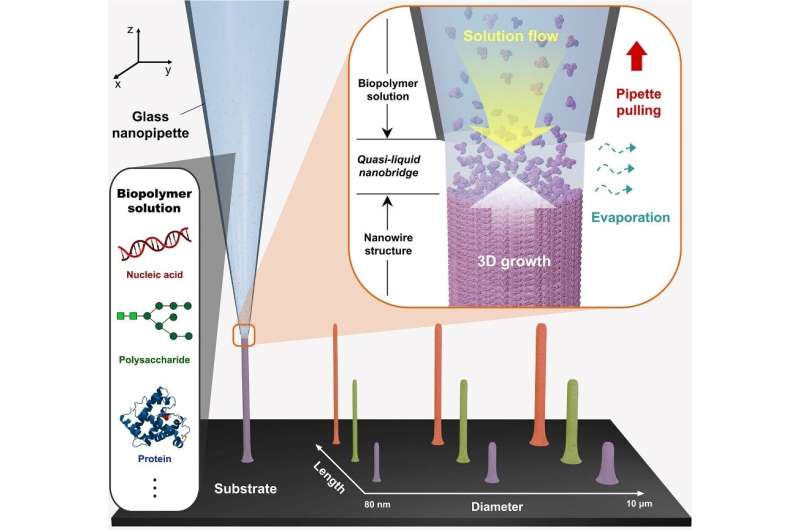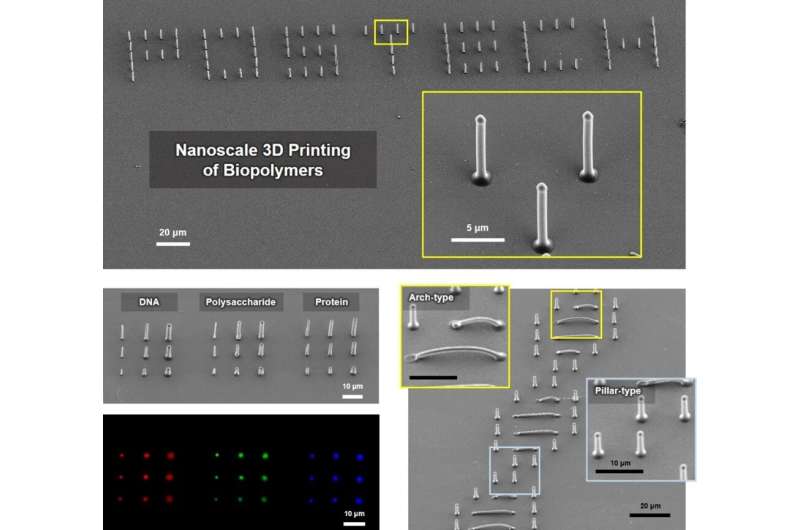Entering a new era of 3D printing for DNAs and proteins

Three-dimensional (3D) bioprinting is a useful technique that has been widely utilized in our lives, ranging from reconstructive plastic surgery to artificial organ production. However, many biopolymers, such as nucleic acids, polysaccharides, and proteins, cannot be readily constructed into a desired 3D shape at the submicron- or nanoscale due to their inherent rheological and structural properties. Can we truly achieve the free-form and high-resolution structuring of various biomolecules using 3D printing technology?
A team of researchers from the Department of Materials Science and Engineering at POSTECH led by Professor Seung Soo Oh, Professor Emeritus Jung Ho Je, Dr. Moon-Jung Yong, and Ph.D. candidates Un Yang and Byunghwa Kang has developed a groundbreaking 3D printing technology that directly allows precise writing and patterning of various biopolymers with full mechanical stability and functional integrity.
Their findings have been published in Advanced Science.
The research team has presented a novel 3D printing strategy that preserves the folding structure and molecular function of various biopolymers by sequentially confining, evaporating, and solidifying a biopolymer-containing solution.
Irrespective of biopolymer types, this technique can produce 3D biopolymeric architectures with precisely-controlled size and geometry at submicron resolution.
Furthermore, it allows the printed biopolymers to exhibit their own desired functions, thereby achieving pin-point localization of spatiotemporal biofunctions, including molecular recognition and catalytic reactions.

This 3D printing technique can be applied in various fields by utilizing the principle that at molecular levels, the evaporation and solidification of pure biopolymer-containing solution occurs regardless of the biopolymer type. It is also highly advantageous that this printing process does not cause any damage or deformation to the biopolymers, due to a mild processing environment under room temperature and ambient air without any additives.
This breakthrough is expected to have wide-ranging applications in the development of materials that can analyze and mimic microscale biological tissues. It can be also applicable to manufacture artificial cells and tissues that can function properly in a biological environment, as well as to produce biochips. The researchers now plan to develop next-generation cell-mimicking device printing methods for practical diagnostics and drug development.
“The significance of this research lies in proving for the first time the possibility of printing 100% functionally and structurally active biopolymers in ultrafine 3D structures,” emphasized Professor Seung Soo Oh, the POSTECH team leader. Professor Emeritus Jung Ho Je commented, “It holds the potential to expand to the printing of various materials with diverse optical and electrical properties, including complex materials such as quantum dots and carbon nanotubes.”
More information:
Un Yang et al, Type‐Independent 3D Writing and Nano‐Patterning of Confined Biopolymers, Advanced Science (2023). DOI: 10.1002/advs.202207403
Citation:
Entering a new era of 3D printing for DNAs and proteins (2023, April 12)
retrieved 13 April 2023
from https://phys.org/news/2023-04-era-3d-dnas-proteins.html
This document is subject to copyright. Apart from any fair dealing for the purpose of private study or research, no
part may be reproduced without the written permission. The content is provided for information purposes only.
For all the latest Science News Click Here
For the latest news and updates, follow us on Google News.

